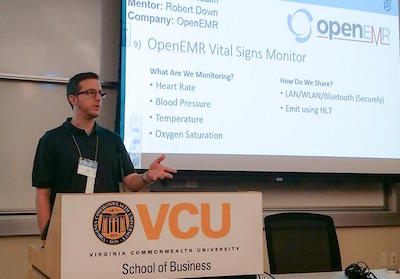OpenEMR Community Releases Major Upgrade to their Open Source EHR
50+ OpenEMR Contributors Produce Staggering Amount of New Features and Improvements for OpenEMR 5.0.1
 RUTLAND, Vt. - April 24, 2018 - PRLog -- OpenEMR, the most popular open source electronic health records (EHR) and medical practice management solution, has announced today that OpenEMR version 5.0.1 has been released.
RUTLAND, Vt. - April 24, 2018 - PRLog -- OpenEMR, the most popular open source electronic health records (EHR) and medical practice management solution, has announced today that OpenEMR version 5.0.1 has been released.
A community of more than 50 OpenEMR contributors produced a staggering amount of new features and improvements for OpenEMR 5.0.1. "The amount of new features and improvements in this new release of OpenEMR is simply astounding and showcases the strengths, diversity, talents, commitment, productivity, and good will of the thriving OpenEMR community," said Dr. Brady Miller, an OpenEMR project administrator, and physician.
The list of new features include a new feature-packed patient portal, institutional billing, basic FHIR support, DICOM image viewer, free e-prescribing, reminders module, group therapy module, active directory support, and clinical role based menus. Improvements involved essentially every module in OpenEMR and included modernization of the user interface, graphing, encryption, document management, messaging, patient tracking, encounter tracking and security. Internationalization and localization were also markedly improved and OpenEMR now supports 34 languages.
 Matthew Vita (left) at the 2017 Nepal-based WONCA SAR conferenceThe new patient portal incorporates a modern user interface and supports scheduling, secure messaging, chat, online payments, customized forms, new patient registration, and CCDA support. "I incorporated feedback from real users in order to provide a feature-packed portal and easy to use interface for patients" stated the author and OpenEMR project integration developer, Jerry Padgett. In addition to this groundbreaking patient portal, Jerry also authored the support for FHIR, which will allow OpenEMR to embrace interoperability into the future.
Matthew Vita (left) at the 2017 Nepal-based WONCA SAR conferenceThe new patient portal incorporates a modern user interface and supports scheduling, secure messaging, chat, online payments, customized forms, new patient registration, and CCDA support. "I incorporated feedback from real users in order to provide a feature-packed portal and easy to use interface for patients" stated the author and OpenEMR project integration developer, Jerry Padgett. In addition to this groundbreaking patient portal, Jerry also authored the support for FHIR, which will allow OpenEMR to embrace interoperability into the future.
The DICOM image viewer provides clinicians a quick, secure, and robust view of patient images with windowing, panning, zooming, and filtering support. "With this release, we are taking the first steps in addressing the gap between imaging systems and the EMR experience," stated Victor Kofia, an OpenEMR volunteer, software engineer and author of the image viewer feature.
The new e-prescription module, entitled WENO, allows free use of e-prescription capabilities. The author of this module, Sherwin Gaddis, OpenEMR vendor, and software engineer, stated: "Weno eRx was designed to provide an affordable system for securely getting the prescription to the pharmacy electronically".
In addition to a large number of new OpenEMR features and improvements, the OpenEMR community was also very busy modernizing installation packages with containerization, docker images, and native cloud support, participating in outreach at conferences and hackathons, supporting Puerto Rico after hurricane Maria, and modernizing OpenEMR's website and online forum.
 Robert Down presenting at 2017 VCU HealthhacksThe support of OpenEMR docker images marks a significant departure from traditional installation processes and offers users a significantly simpler installation solution. This lowers the barrier to getting OpenEMR up and running for "non-technical" users. Additionally, this technology also enables warp-speed development and testing of OpenEMR. "To really touch on how much this technology has made developers lives easier, consider that all OpenEMR community demos and testing servers are running on the cloud in Docker containers. We can simply take a feature that is under active development and present it to our developers and clinicians for review and testing with only a few commands," said Jason Oettinger, an OpenEMR contributor, and medical student.
Robert Down presenting at 2017 VCU HealthhacksThe support of OpenEMR docker images marks a significant departure from traditional installation processes and offers users a significantly simpler installation solution. This lowers the barrier to getting OpenEMR up and running for "non-technical" users. Additionally, this technology also enables warp-speed development and testing of OpenEMR. "To really touch on how much this technology has made developers lives easier, consider that all OpenEMR community demos and testing servers are running on the cloud in Docker containers. We can simply take a feature that is under active development and present it to our developers and clinicians for review and testing with only a few commands," said Jason Oettinger, an OpenEMR contributor, and medical student.
With a focus on ease of use and cost-effectiveness, OpenEMR leveraged Amazon Web Services and cutting-edge container technology to provide OpenEMR solutions in the cloud. "Containerized solutions allow OpenEMR administrators a transparent view into every aspect of performance and availability, translating to clean cloud-level scaling and the assurance of secure, testable recovery paths," says Asher Densmore-Lynn, an OpenEMR contributor, and cloud architect.
Matthew Vita, a software developer and project administrator for OpenEMR and Dr. Andre Millet, a physician and medical officer for OpenEMR were pleased to present "Improving Outpatient and Inpatient Care with the OpenEMR Platform" at the 2017 WONCA South Asia Region Conference in Nepal. "Presenting OpenEMR at the Nepal-based WONCA SAR conference to physicians was a great and productive experience," said Matthew.
OpenEMR was a sponsor of the 2017 VCU HealthHacks. Robert Down, an OpenEMR project administrator, and a nursing student represented OpenEMR and was a mentor at this hackathon. "Of all the great things I saw at the event, I think my favorite was seeing people from different fields of expertise come together to build something. This is what makes the open-source community vibrant and strong. This is why I love giving countless hours of my time to the open-source community at large, and specifically OpenEMR." said Robert.
"The OpenEMR 5.0.1 release represents the beginning of a golden age for the OpenEMR community. We are very excited about OpenEMR's future and the positive impact it will have on global health care," said Stephen Waite, OpenEMR vendor, and contributor.
About OpenEMR
OpenEMR is an electronic health record (EHR) system that was originally developed in 2002 by physicians to help them run their practices. As an open-source project, it is maintained and supported by a vibrant community of volunteers and professionals that includes several hundred contributors and is supported by more than 40 companies. OpenEMR is ONC Certified as a Complete EHR, and it is recognized as the most popular open-source electronic health records and medical practice management solution in the world. OpenEMR is downloaded more than 4,000 times per month, and it is estimated that it is used by more than 100,000 medical providers serving more than 200 million patients. OpenEMR has been translated into 34 languages and is used by facilities in more than 100 countries across the globe. Open-source software has changed the world for the better, and OpenEMR is a leader in open-source healthcare software. Costly proprietary EMRs are no lnger the only option. For more information please visit https://www.open-emr.org.
- Tags:
- 2017 Nepal-based WONCA SAR conference
- 2017 VCU Healthhacks
- active directory support
- Amazon Web Services
- Andre Millet
- Asher Densmore-Lynn
- Brady Miller
- CCDA support
- clinical role based menus
- cloud-level scaling
- DICOM image viewer
- Docker containers
- e-prescription module
- EHR interoperability
- EHR usability
- electronic health records (EHR)
- FHIR support
- global health care
- group therapy module
- Hurricane Maria
- institutional billing
- Jason Oettinger
- Jerry Padgett
- Matthew Vita
- medical practice management solution
- ONC Certified as a Complete EHR
- open source EHR
- open health
- Open Med Practice
- open source
- open-source community
- OpenEMR
- OpenEMR docker images
- patient portal
- Puerto Rico
- reminders module
- Robert Down
- Sherwin Gaddis
- Stephen Waite
- Victor Kofia
- Weno eRx
- Login to post comments